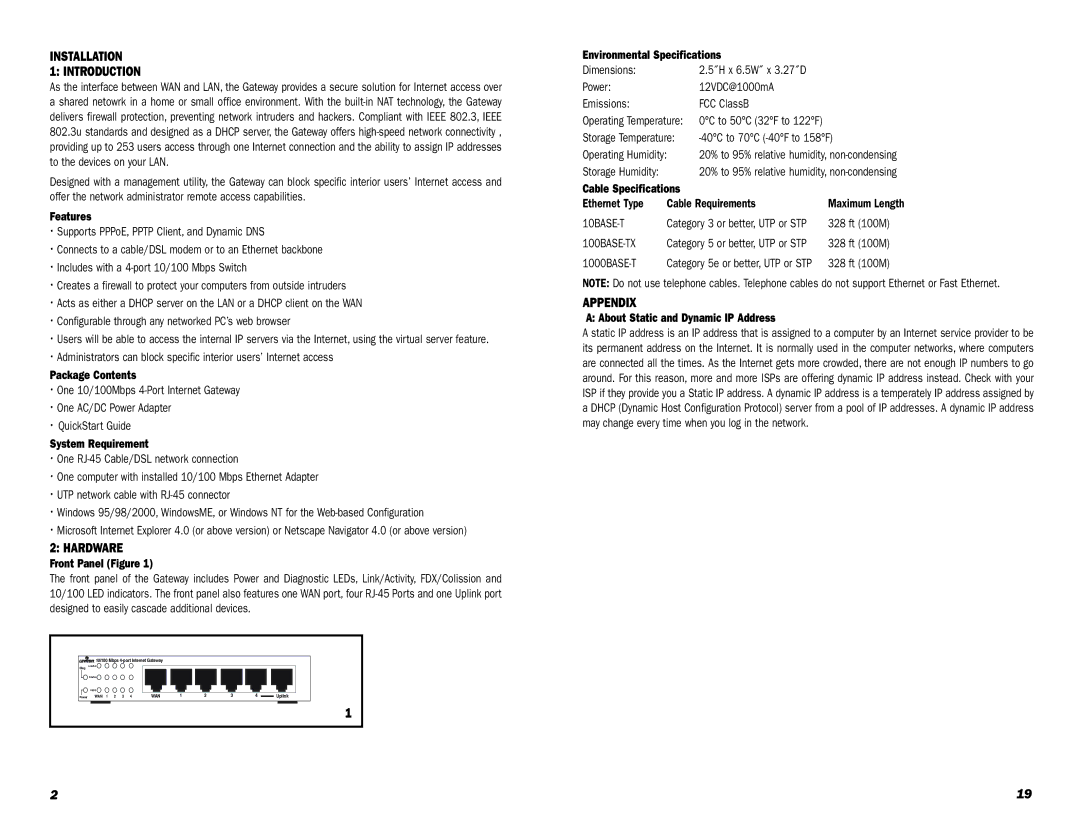
INSTALLATION
1: INTRODUCTION
As the interface between WAN and LAN, the Gateway provides a secure solution for Internet access over a shared netowrk in a home or small office environment. With the
Designed with a management utility, the Gateway can block specific interior users’ Internet access and offer the network administrator remote access capabilities.
Features
·Supports PPPoE, PPTP Client, and Dynamic DNS
·Connects to a cable/DSL modem or to an Ethernet backbone
·Includes with a
·Creates a firewall to protect your computers from outside intruders
·Acts as either a DHCP server on the LAN or a DHCP client on the WAN
·Configurable through any networked PC’s web browser
·Users will be able to access the internal IP servers via the Internet, using the virtual server feature.
·Administrators can block specific interior users’ Internet access
Package Contents
·One 10/100Mbps
·One AC/DC Power Adapter
·QuickStart Guide
System Requirement
·One
·One computer with installed 10/100 Mbps Ethernet Adapter
·UTP network cable with
·Windows 95/98/2000, WindowsME, or Windows NT for the
·Microsoft Internet Explorer 4.0 (or above version) or Netscape Navigator 4.0 (or above version)
2: HARDWARE
Front Panel (Figure 1)
The front panel of the Gateway includes Power and Diagnostic LEDs, Link/Activity, FDX/Colission and 10/100 LED indicators. The front panel also features one WAN port, four
![]()
![]() 10/100 Mbps
10/100 Mbps
Link/Act |
|
|
|
|
|
|
Diag |
|
|
|
|
|
|
Fdx/Col |
|
|
|
|
|
|
100/10 |
|
|
|
|
|
|
Power WAN 1 2 3 4 | WAN | 1 | 2 | 3 | 4 | Uplink |
1
Environmental Specifications | |
Dimensions: | 2.5˝H x 6.5W˝ x 3.27˝D |
Power: | 12VDC@1000mA |
Emissions: | FCC ClassB |
Operating Temperature: | 0°C to 50°C (32°F to 122°F) |
Storage Temperature: | |
Operating Humidity: | 20% to 95% relative humidity, |
Storage Humidity: | 20% to 95% relative humidity, |
Cable Specifications |
| |
Ethernet Type | Cable Requirements | Maximum Length |
Category 3 or better, UTP or STP | 328 ft (100M) | |
Category 5 or better, UTP or STP | 328 ft (100M) | |
Category 5e or better, UTP or STP | 328 ft (100M) | |
NOTE: Do not use telephone cables. Telephone cables do not support Ethernet or Fast Ethernet.
APPENDIX
A: About Static and Dynamic IP Address
A static IP address is an IP address that is assigned to a computer by an Internet service provider to be its permanent address on the Internet. It is normally used in the computer networks, where computers are connected all the times. As the Internet gets more crowded, there are not enough IP numbers to go around. For this reason, more and more ISPs are offering dynamic IP address instead. Check with your ISP if they provide you a Static IP address. A dynamic IP address is a temperately IP address assigned by a DHCP (Dynamic Host Configuration Protocol) server from a pool of IP addresses. A dynamic IP address may change every time when you log in the network.
2 | 19 |
